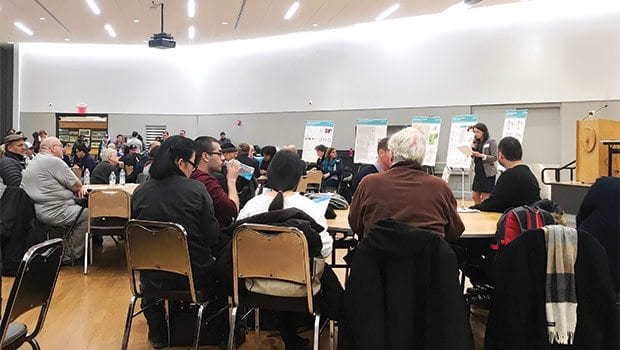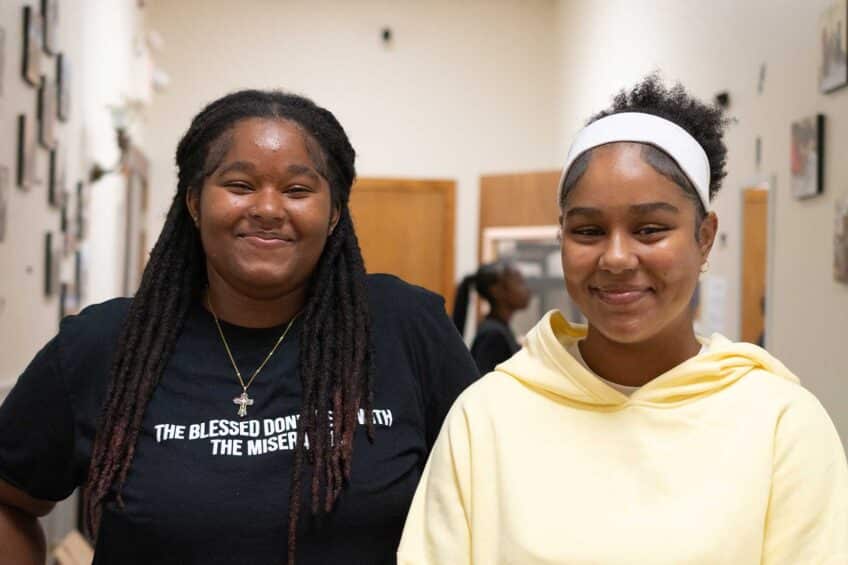BPDA officials discuss Glover’s Corner planning process
Back and forth between residents and city planners continues at workshop

The Boston Planning and Development Agency hosted another community workshop last week to discuss the future of Glover’s Corner. The meeting highlighted continued concerns about how future development will impact the area. The BPDA scheduled the roundtable-discussion event after a city-led meeting last month was interrupted by local activists voicing concerns about displacement of low-income residents and people of color in Dorchester.
“We know that our city is growing and changing and we think it’s important that we work together proactively,” BPDA Planner Cecilia Nardi told the audience assembled at the IBEW Local 103 hall on Jan. 10. She said the process includes “identifying what to preserve and enhance — as well as where and how the neighborhood can grow.”
Planning vs. development
“Last workshop we also heard a lot of questions about the planning process itself,” she continued, in an apparent nod to the public action taken by the Dorchester Not 4 Sale activist group at the last meeting. “So tonight we would like to have an open dialogue about the process itself and set agenda questions for next meeting.”
Nardi noted the difference between planning and development, saying that the desired outcome for this series of BPDA-led discussions on Glover’s Corner would be a formal document laying out guidelines for future projects. The city planning agency began this planning initiative last January, starting with a question campaign followed by a series of community workshops.
Last week’s event consisted of breaking up into small roundtable groups of roughly 10 people each, led by city planners who prompted residents to discuss the future of the neighborhood along three themes: their fears, their hopes, and their questions.
A discussion at one table illustrated the interplay between various residents’ vision for the community, as well as concerns from some about which priorities would eventually gain backing by the city.
“This is where we built our home,” said resident Cindy Tao, recounting the story of how Vietnamese refugees had established a community in the area. “My question is: why pick Glover’s Corner for planning? It’s primarily immigrants, and development could be taking away what people came to build.”
Some local homeowners at the table seemed to share her concerns about the outcome of future development.
“I’m concerned the neighborhood will become flattened out by income and ethnicity, and lose its character,” said Jeff Klein, who has owned a home in Dorchester for 40 years. “That’s the way I see things going in my own neighborhood.”
“A lot of people are being moved out to places like Brockton or Randolph,” added Winston Woods, evoking some nods from others. “I almost ended up in Brockton myself.”
Woods said that he was able to purchase a home recently in Dorchester with some assistance from the city, after realizing that it was actually more cost-effective for him than renting in the long term. He also noted his desire to preserve local diversity.
“My hope is that we will live together, different ethnicities and all, and greet each other on the streets. [But] a lot of times you don’t know there are developments coming — all of a sudden you’re walking along and there are these high rises,” he said.
Lines of communication
In response to this last point, the table’s discussion leader, city planner Chris Busch, said that the BPDA does regularly engage in lengthy community discussions on any given project. But he conceded that there may be room for improvement on how the agency communicates with the community. The point sparked a different concern from a resident.
“I’ve been coming to meetings about Glover’s Corner for years,” said resident Pat O’Neill, registering her frustration with what she said felt like an endless planning process. She said she thinks the area “needs a lot of work.”
Residents at the table did raise some points about the type of development that they thought would be beneficial to those already living or working in the area, ranging from improved lighting for better safety at night to investments that would benefit small family-owned businesses rather than large chains.
O’Neill also advised those at the table that in her experience as the president of the Ashmont Adams Neighborhood Association, the best way to make concerns heard at the city was through the local civic associations.
“If people bring their gripes to me, I call City Hall,” she said. “That’s where the grass roots should be. If anybody wants to take the reins in your neighborhood and do it, I mean, do it.”
Nadine Fallon, who is on the Jones Hill civic association and also on the Glover’s Corner Advisory Group, agreed.
“Please come to the meetings,” she said. “It’s such a challenge to get people to come to the meetings. And that’s the only way you’re going to have a voice.”
She then asked those at the table for their input on how to better improve communication between the Advisory Group and local residents. Participants raised a number of ideas, including more proactive outreach and more in-person communication. One idea that generated particular enthusiasm was to spread information about city planning initiatives through school networks, since students would generally share such information with their families.
Accessibility
“Are you going to the different spaces that people are utilizing?” resident Kevin Lam asked, summarizing the issue.
But the discussion also raised larger issues that went beyond the Glover’s Corner area. One was the concern that the city’s main method of communication about local planning came in the form of meetings on weekday evenings, when those working night jobs or raising small children could not attend. Some also noted the meeting’s location, which is not easily accessible by public transportation. As an example, one young woman at the table said that she came primarily on behalf of her grandmother, who could not attend but had a vested interest in the discussion as someone living on rent assistance.
More questions
People also raised the matter of how the city choses Advisory Group members in the first place. Advisory Group member Nadine Fallon, who happened to be sitting at the table, said that she had applied as a local business owner concerned about the area’s future and had been readily accepted. She noted that Advisory Group members had been encouraged to reach out to their networks and recruit more people. But another table member noted that one of his friends, who is a local resident, had applied and not been accepted.
This discussion also prompted table members to ask whether there were people of color on the Advisory Board. Fallon said there were, but that the city had not formally raised the issue with group members.
Lastly, some questioned how transparent the city was being about plans for the area’s future. While the city officials at the meeting confirmed there is nothing concrete in the pipeline for Glover’s Corner, some attendees at the meeting remained unconvinced.
“The bigger question is: who is making the decisions?” said Klein. “I’m sorry to be cynical about it, but in the end, the BPDA can pay attention or not pay attention. Where is the accountability?”
Lam registered similar concerns. “Are there already plans for development in Glover’s Corner and we are just having this process so they can move forward?” he asked. “Why are we not talking about stabilization and preservation first before we even talk about development?”






